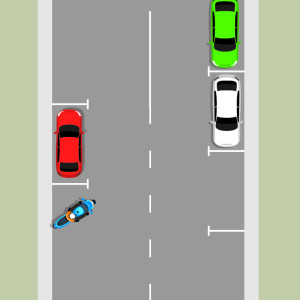One of the most important things you can do to be a safer rider is to look well ahead of you when you’re riding, so you can pick up potentially dangerous situations before it’s too late. Keep your eyes up for balance and control.
The earlier you spot a potential hazard, the more time you'll have to take evasive action if you need to.
Rather than looking only as far as the vehicle in front of you when riding, you should actually be scanning the road in front to a distance of at least 12 seconds ahead of you – that is, the place you'll be after riding for 12 seconds.
As a rough guide, at 50km/h, 12 seconds is 166 metres or about 2 city blocks. At 100km/h, 12 seconds is 333 metres. This means at 100km/h you should look ahead as far as you can see.
Use your height advantage to look over or through the vehicle in front of you, so you can see what’s going on ahead.
Many people only look ahead of them when riding. This means they’re not getting the full picture of what’s happening on the road.
As well as looking ahead, you should also use your mirrors to look to the sides and behind often, to be aware of surrounding traffic. This helps you spot potentially dangerous situations that could be forming around or behind you.
Moving your eyes regularly and concentrating on what’s going on around you will also help you to stay alert on long journeys.
Motorcycles have blind spots just like other vehicles. When you change lanes, make sure you turn your head and look over your shoulder, in the direction you intend to move, at traffic behind you.
This head check is the only way to see a car behind you in the next lane.
As a motorcycle rider, you can put yourself in a position to see things that a driver of a car can't see.

Angle your motorcycle to see both ways
You should create a cushion of safety around your whole vehicle by making sure there is a safe distance in all directions between you, other vehicles and potential hazards.
This'll give you and other road users more time and space to avoid any hazards.
ImportantThe cheapest insurance you can have is space around your vehicle. The more space you have, the safer you will be. |
It’s easy to get distracted when you’re riding. Things like a talking pillion passenger, passing scenery and roadside advertising can all divert your attention from your riding and the road.
You must learn to ignore distractions and concentrate on riding. If you need to look away from the road, follow these pointers:
Following the tips above will help you avoid many potentially dangerous crashes. However, there may still be times when you find yourself on a direct collision course with another vehicle or other hazard.
For this reason, it's good to identify possible escape routes all the time while you’re on the road. That way, if you find yourself in danger of a crash, you’ll be ready to take quick evasive action.
Most escape routes will be to your left, so take note of what’s on the left-hand side of the road as you ride. Ask yourself questions like:
If there are no safe escape routes, reduce your speed and increase your following distance so you can stop in plenty of time if a crash situation develops.